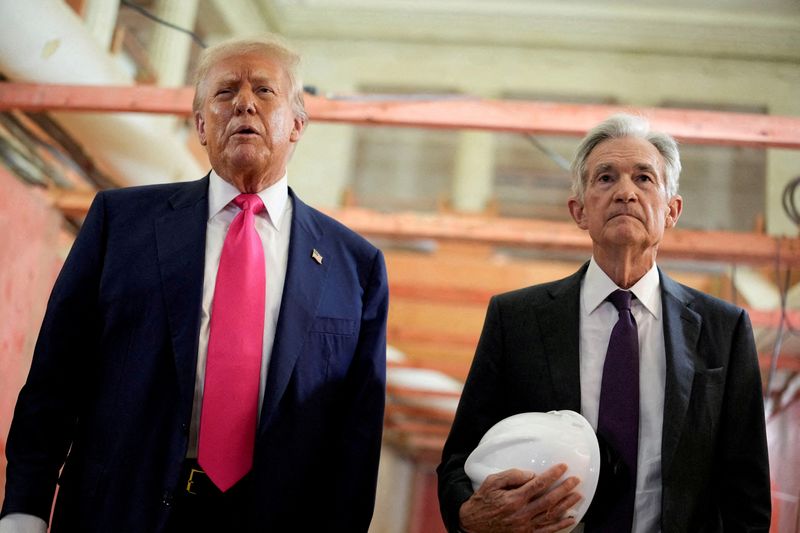
By Howard Schneider
JACKSON HOLE, Wyoming (Reuters) -U.S. Federal Reserve Chair Jerome Powell's speech to the annual Jackson Hole economic conference on Friday comes amid unprecedented pressure on the central bank from President Donald Trump, but mixed economic data may pull Powell toward a middle ground that leaves major questions unresolved.
Investors are expecting and Trump is demanding a rate cut when the Fed meets next month, and two Fed governors began pushing for cuts with dissents at the central bank's last policy meeting on concerns the labor market may be weakening faster than headline employment data suggests.
But inflation remains above the Fed's 2% target and is expected to move higher as the cost of Trump's import tariffs works its way into retail prices, a reason for caution in lowering rates during a price-adjustment process some policymakers feel may last into next year.
Lowering rates while prices are rising and inflation is still above target could send a dangerous message to consumers from a Fed whose credibility in controlling inflation is one of its major assets, Kansas City Fed President Jeffrey Schmid said in a CNBC interview taped on Wednesday night ahead of the conference kick-off. Schmid, the conference host, has voted this year with the majority to keep rates unchanged at 4.25% to 4.50%.
"The credibility of our anchoring in on that inflation number...is a very important piece," Schmid said. "I think we got to be careful about what lowering short-term rates would do to the inflation mentality" with prices still rising faster than the Fed's target and expected to accelerate.
Powell speaks at 10 a.m. EDT (1400 GMT) in what will likely be his valedictory address to the Fed's premier research forum, with his term as chair ending in May. His remarks are also expected to reveal a new Fed operating framework that streamlines the more complex set of principles unveiled to the conference five years ago.
On rate policy, some analysts expect a possible compromise. Powell could open the door to a September cut in acknowledgement of weaker job growth and the need to ensure it doesn't weaken further without committing to anything more until policymakers become more certain any increase in inflation will fade and prove a one-time jump in prices.
That is unlikely to satisfy Trump, who says rates should be slashed to around 1%, or investors betting on multiple cuts this year - though faith in even a September reduction has been wavering.
"The constant refrain that monetary policy is restrictive doesn't really fit the data...And unless I believe there's going to be an absolute cratering of the labor market, which doesn't seem to be there, it all looks much more biased to inflation," said Adam Posen, president of the Peterson Institute for International Economics and a former member of the Bank of England's monetary policy committee. "I see the forecast...continuing in the direction of stagflation, increasing inflation, slowing growth."
Still, Posen says a cut is likely as "insurance" for the job market, "and partly, though they won't say it, politically to buy time, because if they don't cut then it just gets even more fraught."
TRUMP PRESSURE
With Trump's words and actions increasingly seen as a threat to the Fed's independent status, the political context in which Powell and the Fed are operating has become an increasing part of the story - tangling communications in which almost any decision is now seen as capitulation to or unreasonable defiance of Trump, not a fact-based balancing of risks.
Trump has leveled intense personal attacks on Powell and called on him to resign, with some in his administration encouraging a move to fire him "for cause" over cost overruns at a Fed building renovation project. He and other Fed Board of Governors members cannot be fired over disagreements about monetary policy.
On Wednesday Trump demanded that Fed Governor Lisa Cook resign over allegations that she took out mortgages on properties in Michigan and Georgia while listing both as a primary residence, which can influence financing rates.
Cook has said she won't be "bullied" from office, but a widening battle for control of the Fed, considered an anchor institution of the global financial system, could be in the offing if the administration looks to not just name a new chair when Powell's term ends, but try to open more board seats. As it stands, three Fed governors appointed by former President Joe Biden, including Cook, serve terms that outlast Trump's remaining time in office.
So far, said William English, former head of the Fed's monetary affairs division and now a professor at the Yale School of Management, the Fed has maintained its policy independence.
"Powell has hung in well. The board and the Reserve Bank presidents are sticking to their guns," English said. "Congress set up the Fed...to get some independence from the administration...It works so long as the Congress and the courts don't change the rules."
But if board members resign or are pressured out early, it would give the White House more influence over monetary policy as well as over the 12 Reserve Bank presidents, whose hiring, while done through local boards, must pass muster with Washington.
Over time, "we worry more about this process of Trumpification eroding Fed independence and leading to a lurch in the Fed reaction function" towards lower rates perhaps as soon as next year, wrote former New York Fed staffer Krishna Guha, currently vice chair of Evercore ISI. The key factor may well be the extent to which the Fed board turns over in 2026, allowing Trump to reshape the Fed more extensively. This will turn on a handful of very personal decisions by current Fed governors."
Trump has nominated Council of Economic Advisers chair Stephen Miran to fill one unexpected vacancy created when Governor Adriana Kugler resigned before the January 31 end of her term.
(Reporting by Howard Schneider; Editing by Andrea Ricci)

 Reuters US Economy
Reuters US Economy
 Raw Story
Raw Story Esquire
Esquire KLCC
KLCC Roll Call
Roll Call The Daily Mash
The Daily Mash KCCI 8 Politics
KCCI 8 Politics The Hill Video
The Hill Video